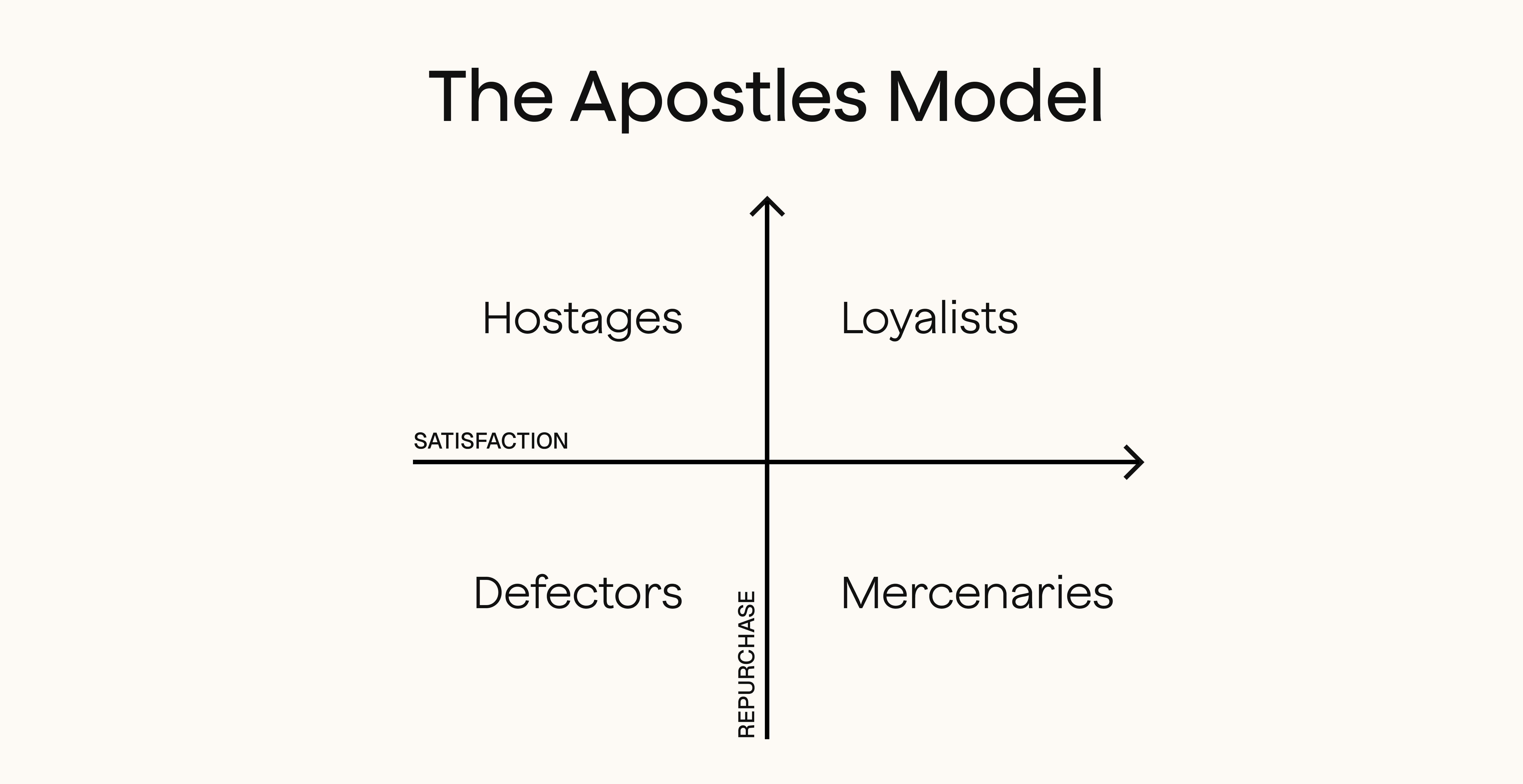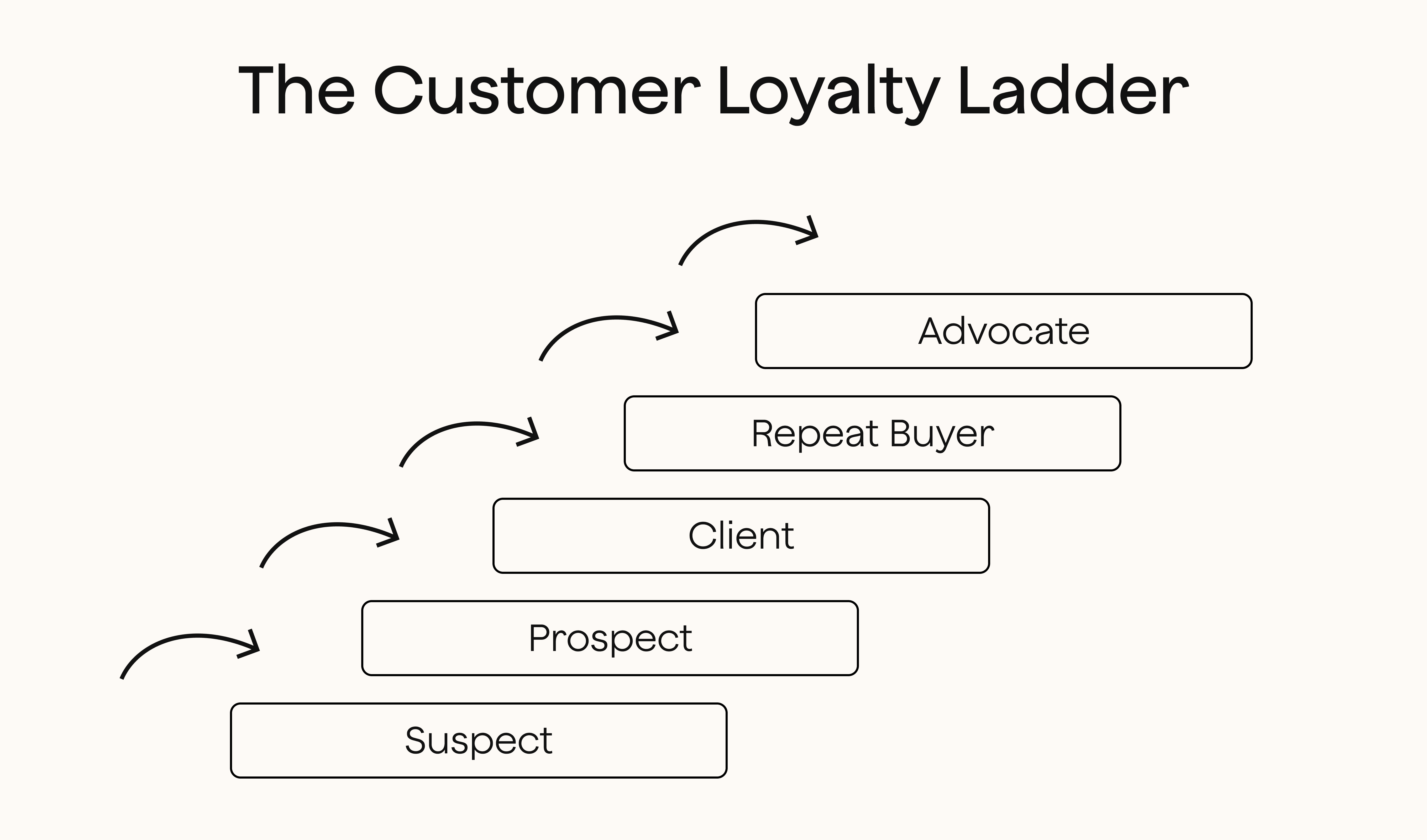
May 1, 2025
– 6 minute read
Discover six proven customer loyalty models, from the Apostle Model to Dick & Basu’s, and learn how to apply each to boost customer loyalty.

Cormac O’Sullivan
Author
A solid customer loyalty model turns data into action. It’s a blueprint that explains why existing customers return, how they engage with your product or service, and which retention strategies work best. By mapping loyalty drivers - emotional connection, satisfaction, advocacy - you build a targeted plan for repeat business and long-term customer relationships.

What Is a Customer Loyalty Model?
A customer loyalty model is a structured way to understand and predict how customers interact with your brand over time. With a clear model, you can tailor retention strategies, refine your loyalty program, and enhance customer experiences.
Key Components of Customer Loyalty Models
A strong model includes:
Behavioral factors, such as repeat purchase rates or referral rates.
Attitudinal factors, such as satisfaction or emotional connection.
Engagement metrics, such as frequency of feedback or social shares.
Value measures, such as average order value or customer lifetime value.
Exploring 6 Customer Loyalty Models and How to Apply Them
The Apostle Model of Customer Loyalty

The Apostle Model, introduced by Harvard Business School researchers, segments customers into four key groups based on satisfaction and loyalty levels. These groups form a quadrant that's based on the axes of satisfaction and loyalty:
Loyalists are highly satisfied and have high loyalty. They're highly satisfied and repeat purchasers who actively recommend your product or service.
Mercenaries are highly satisfied but have low loyalty. While satisfied, they switch brands for better deals.
Hostages are highly loyal but have low satisfaction. They feel compelled to stay - often due to contracts or lack of alternatives - but aren’t happy.
Defectors have low loyalty and low levels of satisfaction. Sometimes called “terrorists”, they are both dissatisfied and disloyal, prone to churning and negative word-of-mouth.
By mapping your customer data onto this matrix, you gain clarity on where to focus your retention strategies. Apostles become champions in your customer loyalty program - offer them early access to new products or VIP events to deepen their advocacy. For Mercenaries, introduce targeted promotions tied to their purchase history to foster repeat business. Hostages require improved customer experiences and tailored support to convert apathy into genuine loyalty. And Defectors demand rapid service recovery and personalized outreach to win them back.
Implementing the Apostle Model starts with gathering customer feedback through NPS surveys and satisfaction polls. Combine that with repeat purchase rates to position each customer in the four-segment matrix. Use these insights to tailor communications - whether it’s a special thank-you note for Apostles or a personalized discount for Mercenaries - ensuring every interaction strengthens your loyal customer base.
The Dynamic Model of Customer Loyalty
The Dynamic Model views loyalty as an evolving process rather than a static state. It outlines four stages of the relationship lifecycle:
Expected Value: The benefits a customer anticipates relative to cost, influenced by marketing messages and competitor offers.
Perceived Value: The real experience after purchase, shaped by product quality and customer service.
Value Reinforcement: Ongoing benefits - like exclusive content or loyalty points - that reward repeat business and deepen the emotional connection.
Competitive Comparison: Customers continually weigh your offerings against alternatives, assessing whether to stay loyal or switch.
This model emphasizes continuous engagement and improvement. To apply it, start by benchmarking customer expectations through surveys and social media listening. Then, measure perceived value via post-purchase feedback to ensure positive experiences. Next, reinforce loyalty by delivering incremental rewards - bonus points or early product previews - that prove you value their long-term relationship. Finally, monitor competitive moves and adjust your customer loyalty program to maintain a clear edge.
By tracking loyalty as a journey, you can proactively address drops in perceived value before they lead to churn. Use CRM tools to trigger personalized check-ins when a customer’s purchase gap exceeds their average repeat interval. Continually refine your products and services based on live feedback, cementing retention and fostering sustainable growth.
The Two-Dimensional Model of Customer Loyalty
Richard L. Oliver’s Two-Dimensional Model argues that true loyalty requires both behavioral and attitudinal commitment. Behavioral loyalty is shown through repeat purchases and resistance to switching. Attitudinal loyalty reflects a customer’s positive feelings, trust, and willingness to advocate on social media or in person.
To use this model, collect quantitative data - like repeat purchase rates, subscription renewals, or referral counts - and qualitative insights from satisfaction surveys. Plot each customer on a two-axis grid: one axis for behavior, the other for attitude. This creates four quadrants:
Advocates: High behavior, high attitude. Your best loyal customers - reward them with ambassador perks.
Opportunists: High behavior, low attitude. They buy often but aren’t engaged; increase emotional connection with storytelling and community invites.
Supporters: Low behavior, high attitude. Fans who love your brand but purchase infrequently; nudge them with targeted offers and reminders.
Switchers: Low behavior, low attitude. Least likely to stay; only invest if they show signs of shifting toward habit or advocacy.
Armed with this segmentation, tailor your retention strategies. For Advocates, launch co-creation panels that use their feedback to shape new features. For Supporters, send personalized re-engagement emails based on their wishlist items. By combining attitudes and actions, you build a loyal customer base that not only returns but also champions your offerings over the long term.
Rai Srivastava’s Model of Customer Loyalty
Rai Srivastava’s model views loyalty as the product of both internal and external forces. Internal factors include customer satisfaction, clear expectations, and seamless customer experiences. External factors cover marketing activities, public relations, and brand reputation. Together, they shape whether buyers become repeat purchasers or drift away.
To put this into practice, start by mapping your internal strengths, like fast support response times, and your external touchpoints, such as social media sentiment. Survey existing customers to gauge satisfaction and expectations. Then layer on market research to understand how your reputation compares to competitors.
Use this dual lens to refine your loyalty program: focus on improving the interactions you control (service quality, product consistency) while amplifying your external voice (PR wins, user‐generated content). Over time, balancing these internal and external levers deepens emotional connection and drives a steady stream of repeat business.
The Customer Loyalty Ladder Model

The customer loyalty ladder breaks loyalty into progressive rungs. As customers ascend from Suspects to Prospects to Clients to Repeat Buyers to Advocate, they grow more engaged and committed. Prospects know your brand. Customers make a first purchase. Clients buy repeatedly. Supporters recommend that you informally. Advocates evangelize your products and services publicly.
To apply this ladder, identify where each buyer sits. Use website analytics to spot Prospects and trigger welcome offers that nudge them toward a first purchase. Track purchase frequency to flag Clients and design tiered rewards - like free shipping or bonus points - to entice them to become Supporters. Finally, for Supporters, introduce formal advocacy perks: referral bonuses, exclusive community events, or early access to new lines. By tailoring rewards and messaging at each step, you guide customers upward, turning casual buyers into vocal brand champions who drive repeat business and organic growth.
Dick and Basu’s Model of Customer Loyalty
Dick and Basu’s model defines loyalty through two dimensions: relative attitude (how much a customer likes your brand) and repeat patronage (how often they buy). Customers fall into four segments:
True Loyalty: High attitude + high repeat purchases.
Latent Loyalty: High attitude + low repeat purchases.
Spurious Loyalty: Low attitude + high repeat purchases (often due to convenience or lack of alternatives).
No Loyalty: Low attitude + low repeat purchases.
To leverage this framework, first collect both attitude data (via NPS or satisfaction surveys) and behavior data (purchase history). Plot each customer on a two‐axis grid. For True Loyalty customers, deepen engagement with co-creation programs or ambassador perks. Latent Loyalty customers need incentives - like targeted offers - to convert positive feelings into action.
Spurious Loyalty buyers benefit from boosted brand experiences to turn convenience into genuine preference. For customers showing No Loyalty, re-engagement campaigns or exit surveys can reveal barriers and guide improvements. This segmentation ensures your retention strategies match each customer’s unique loyalty profile, boosting long-term relationships and repeat business.
Conclusion
Customer loyalty models give you a clear map of why people stay and why they leave. From the Apostle Model’s four customer types to the Customer Loyalty Ladder’s step-by-step climb, each framework offers practical ways to boost repeat purchases and long-term relationships.
By combining data on attitudes and behaviors, you can tailor your loyalty program, refine retention strategies, and turn occasional buyers into brand champions. Use these models as a guide to design offers, improve experiences, and build a loyal customer base that fuels steady growth.



